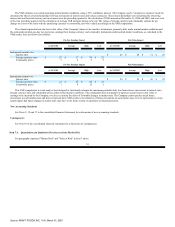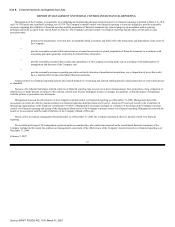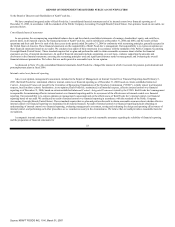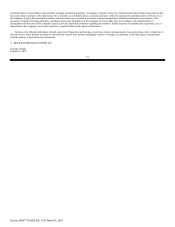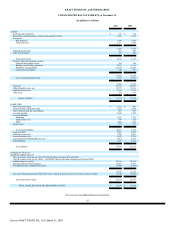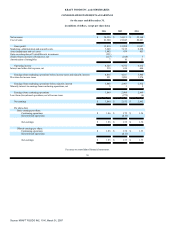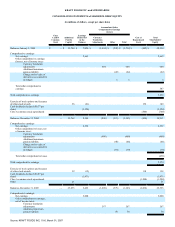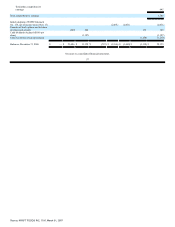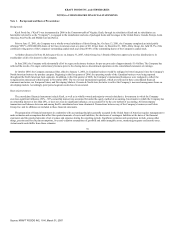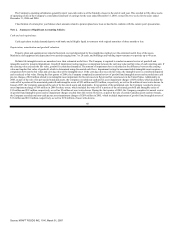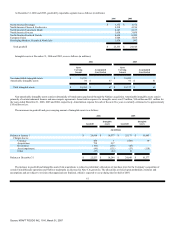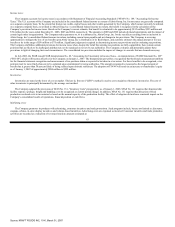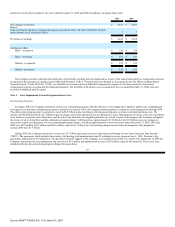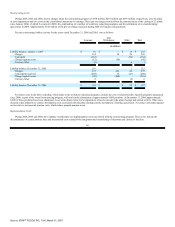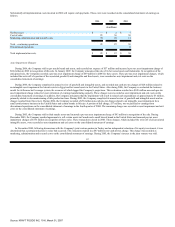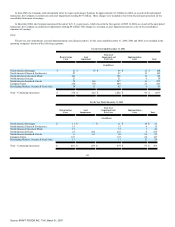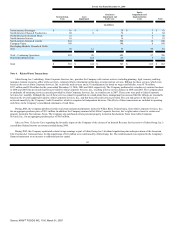Kraft 2006 Annual Report Download - page 65
Download and view the complete annual report
Please find page 65 of the 2006 Kraft annual report below. You can navigate through the pages in the report by either clicking on the pages listed below, or by using the keyword search tool below to find specific information within the annual report.
The Company's operating subsidiaries generally report year-end results as of the Saturday closest to the end of each year. This resulted in fifty-three weeks
of operating results in the Company's consolidated statement of earnings for the year ended December 31, 2005, versus fifty-two weeks for the years ended
December 31, 2006 and 2004.
Classification of certain prior year balance sheet amounts related to pension plans have been reclassified to conform with the current year's presentation.
Note 2. Summary of Significant Accounting Policies:
Cash and cash equivalents:
Cash equivalents include demand deposits with banks and all highly liquid investments with original maturities of three months or less.
Depreciation, amortization and goodwill valuation:
Property, plant and equipment are stated at historical cost and depreciated by the straight-line method over the estimated useful lives of the assets.
Machinery and equipment are depreciated over periods ranging from 3 to 20 years, and buildings and building improvements over periods up to 40 years.
Definite life intangible assets are amortized over their estimated useful lives. The Company is required to conduct an annual review of goodwill and
intangible assets for potential impairment. Goodwill impairment testing requires a comparison between the carrying value and fair value of each reporting unit. If
the carrying value exceeds the fair value, goodwill is considered impaired. The amount of impairment loss is measured as the difference between the carrying
value and implied fair value of goodwill, which is determined using discounted cash flows. Impairment testing for non-amortizable intangible assets requires a
comparison between the fair value and carrying value of the intangible asset. If the carrying value exceeds fair value, the intangible asset is considered impaired
and is reduced to fair value. During the first quarter of 2006, the Company completed its annual review of goodwill and intangible assets and recorded non-cash
pre-tax charges of $24 million related to an intangible asset impairment for biscuits assets in Egypt and hot cereal assets in the United States. Additionally, in
2006, as part of the sale of its pet snacks brand and assets, the Company recorded non-cash pre-tax asset impairment charges of $86 million, which included the
write-off of a portion of the associated goodwill and intangible assets of $25 million and $55 million, respectively, as well as $6 million of asset write-downs. In
January 2007, the Company announced the sale of its hot cereal assets and trademarks. In recognition of the anticipated sale, the Company recorded a pre-tax
asset impairment charge of $69 million in 2006 for these assets, which included the write-off of a portion of the associated goodwill and intangible assets of
$15 million and $52 million, respectively, as well as $2 million of asset write-downs. During the first quarter of 2005, the Company completed its annual review
of goodwill and intangible assets and no impairment charges resulted from this review. However, as part of the sale of certain Canadian assets and two brands,
the Company recorded total non-cash pre-tax asset impairment charges of $269 million in 2005, which included impairment of goodwill and intangible assets of
$13 million and $118 million, respectively, as well as $138 million of asset write-downs.
60
Source: KRAFT FOODS INC, 10-K, March 01, 2007


